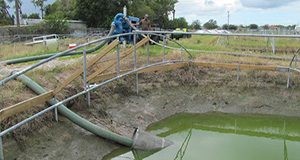Abstract
Structural strategies to prevent the escape of non-native species from aquaculture facilities have numerous environmental benefits, and research at the UF/IFAS Tropical Aquaculture Laboratory has shown that structural strategies also reduce non-compliance with Florida Department of Agriculture and Consumer Services Best Management Practices. Operational and management strategies, however, are also very important. The strategies discussed in this 6-page fact sheet, the management of water, facilities, and employees, must not be overlooked. Operational strategies are easy, inexpensive, and, when used alongside structural strategies, highly effective, offering an impressive return on a minimal investment in the overall effort to minimize the escape of non-native species.
This fact sheet is the fourth in a four-part series devoted to educating industry and other stakeholders on the importance of preventing escape of non-native species from aquaculture facilities, as well as strategies for non-native species containment and regulatory compliance. Written by Quenton M. Tuckett, Carlos V. Martinez, Jared L. Ritch, Katelyn M. Lawson, and Jeffrey E. Hill, and published by the School of Forest Resources and Conservation, Program in Fisheries and Aquatic Sciences, August 2016.
References
FDACS. 2015. Aquaculture Best Management Practices Rule. Florida Department of Agriculture and Consumer Services, Division of Aquaculture, Tallahassee, FL.
Finlayson, B. J., R. Schnick, D. Skaar, J. Anderson, L. Demong, D. Duffield, W. Horton, and J. Steinkjer. 2010. Planning and Standard Operating Procedures for the Use of Rotenone in Fish Management; Rotenone SOP Manual. American Fisheries Society, Bethesda, Maryland.
Hill, J. E., Q. M. Tuckett, C. V. Martinez, J. L. Ritch, and K. M. Lawson. 2016. Preventing escape of non-native species from aquaculture facilities in Florida, part 2: facility evaluation strategies. FA196. Gainesville: University of Florida Institute of Food and Agricultural Sciences. http://edis.ifas.ufl.edu/fa196.
Shireman, J. V., and C. E. Cichra. 1994. "Evaluation of aquaculture effluents." Aquaculture 123:55-68. https://doi.org/10.1016/0044-8486(94)90119-8
Tuckett, Q. M., C. V. Martinez, J. L. Ritch, K. M. Lawson, and J. E. Hill. 2016a. Preventing escape of non-native species from aquaculture facilities in Florida, part 1: general considerations and regulations. FA195. Gainesville: University of Florida Institute of Food and Agricultural Sciences. http://edis.ifas.ufl.edu/fa195.
Tuckett, Q. M., C. V. Martinez, J. L. Ritch, K. M. Lawson, and J. E. Hill. 2016b. Preventing escape of non-native species from aquaculture facilities in Florida, part 3: structural strategies. FA197. Gainesville: University of Florida Institute of Food and Agricultural Sciences. http://edis.ifas.ufl.edu/fa197.
Tuckett, Q. M., J. L. Ritch, K. M. Lawson, and J. E. Hill. 2014. Best management practices and escapement of non-native fish from aquaculture facilities in Florida. Final Report. Florida Department of Agriculture and Consumer Services. Tallahassee, Florida.
Tuckett, Q. M., J. L. Ritch, K. M. Lawson, and J. E. Hill. 2016c. "Implementation and Enforcement of Best Management Practices for Florida Ornamental Aquaculture with an Emphasis on Nonnative Species." North American Journal of Aquaculture 78:113-124. https://doi.org/10.1080/15222055.2015.1121176

